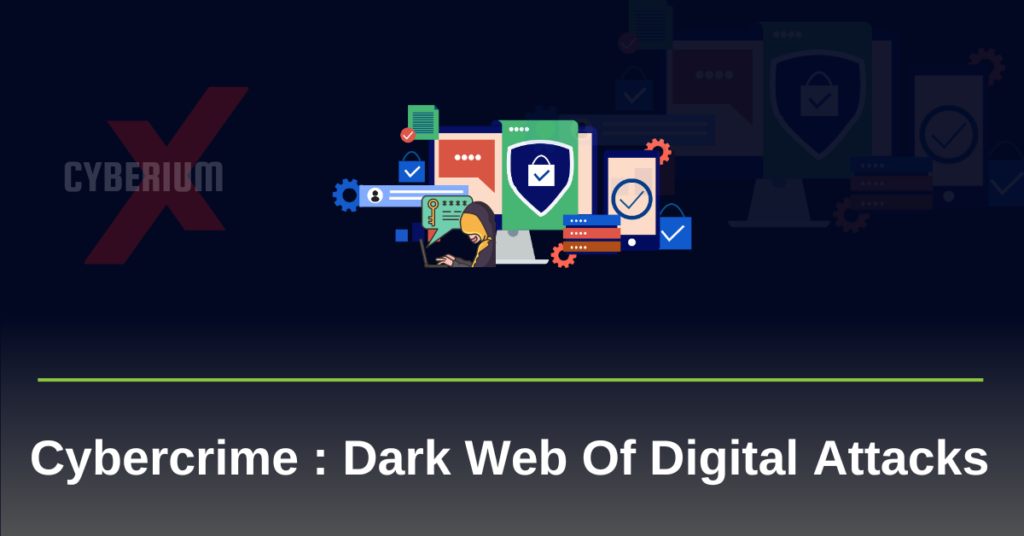Introduction
Technology has provided unparalleled ease and connectivity to our digital age, but it has also given rise to a worrying phenomenon: cybercrimes. These are illegal operations carried out online that have as their targets people, businesses, and even governments. In this blog, we’ll go into the world of cybercrimes and examine their types, effects, countermeasures, and roles in law enforcement.
What is Cybercrime?
In today’s world, cybercrime has become one of the major problems that people all over the world face. So, what exactly is cybercrime? Cybercrime is a crime that is committed with the use of a networked device, or a computer, for any purpose. Those who commit cybercrimes are known as cybercriminals.
A cybercriminal may use your device to get your personal info, your business info, government info, or even take your device offline. A cybercriminal can also sell or acquire the information listed above online. It is happening all around the world on a daily basis. Cybercriminals are the people who are good at hacking and taking advantage of technology. They usually do their best work in places where there’s a ton of digital data.
Top Common Types of Cybercrimes
Below are some of the most common cybercrimes around the world.
Impersonation/Identity Theft
Child Pornography
SIM Swap Scam
Website Defacement
Phishing
Malware and ransomware
Cyber Stalking
Data Breach
Cybersquatting
Cyber Bullying
Online Sextortion
Impersonation/Identity Theft
Identity Theft is a criminal activity in which an individual’s personal and confidential data is unlawfully accessed by cyber criminals. This data, which may include social security information, credit card information, and password information, is used for the purpose of obtaining financial gain, fraud, and other criminal activities. As digital transactions and digital presence have become increasingly prevalent, the potential for identity theft has increased significantly.
Criminals use a variety of methods to obtain personal information, including phishing, data breach, and cyber-attacks. Once this information is obtained, it can cause a wide range of damages to victims, from financial losses to psychological trauma. Many victims spend years recovering from the consequences, dealing with banks, credit bureaus, and law enforcement agencies.
Child pornography
Child pornography is a type of sexual exploitation of children. According to federal law, child pornography is any visual representation of sexual activity involving a minor (under the age of 18). Images of child pornography may also be referred to as images of child sexual abuse.
There are different types of child pornography, like images of a minor engaging in sexual activity, showing certain parts of their body for sexual purposes, encouraging a minor to engage in a sexual activity, or showing a minor engaging in a sexual activity that is illegal. These types of child pornography can be found in a variety of places, like photos, videos, writing, or audio recordings.
SIM swap scams
SIM swap scams are a type of fraud in which cybercriminals take advantage of weaknesses in a mobile phone’s operating system to access a victim’s personal data and accounts without authorization. What is SIM swap scam? In SIM swap scams, cybercriminals use social engineering and phishing attacks to gain access to the victim’s phone number and other personal information. Once they have this information, they pose as the victim and contact their mobile service provider to ask them to transfer their phone number into a new SIM that they own.
Website defacement
Website defacement is the act of maliciously altering the look and feel of a website. It is usually done as part of a hacktivism campaign or to demonstrate the attacker’s abilities. The attackers take advantage of weaknesses in the website’s security to access the original content and replace it with their own message, image, or even a political statement. When a website is defaced, it is often displaying messages that are either political, social or ideological in nature. It can also contain explicit content or even messages that promote the attacker’s own agenda.
The purpose of website defacement is to cause embarrassment to the website owner. It can also be used to spread a specific message or to cause chaos and disruption.
Phishing Attacks
Phishing is a type of malicious cyberattack that seeks to deceive individuals into providing personal information, including usernames and passwords, as well as credit card and personal identification information. Phishing attacks are typically conducted through deceptive emails, messages or websites that masquerade as legitimate entities in order to deceive recipients into believing they are communicating with a reliable source.
Cyberstalking
Cyberstalking is the practice of harassing, stalking, tracking, and intimidating people online through the use of digital communication tools and technologies. The purpose of cyberstalking is to harass, monitor, monitor, and threaten the victim, causing them emotional distress, and invading their privacy. The most common types of cyberstalkers are: Social media users Email users Instant messaging users Other online tools used by cyberstalkers Sending threatening messages Spreading false information Sharing personal data without consent Creating fake profiles to pretend to be the victim Monitoring their online presence
Data breach
A data breach is an unauthorized access, disclosure, or theft of confidential, personal, or sensitive information. It can occur as a result of a cyberattack, hacking incident, accidental disclosure, or due to internal negligence. A data breach can result in the loss of personal information, financial information, login information, or other sensitive data. It can also lead to identity theft, fraud, damage to reputation, and legal consequences. Data breaches can be sold online, used in phishing campaigns, or used in a variety of other ways by criminals.
Cybersquatting
Cybersquatting involves the registration of domain names that mimic well-known trademarks, brand names, or popular domain names with the intention to capitalize on the confusion or tarnish the original owner’s reputation. These domains can be used for advertising, impersonating legitimate brands, charging exorbitant fees for release, or redirecting web traffic to gain a competitive edge. Cyberquatting harms intellectual property, brand integrity, and consumer confusion. Fortunately, there are legal remedies available to trademark owners. These remedies include registering your trademark, keeping an eye on your domain, and taking legal action against cybersquatters as soon as possible to protect your brand and online presence.
Cyberbullying
Cyberbullying is a type of online harassment that uses digital communication tools to bully, degrade, or threaten people. It includes things like sending hurtful texts, spreading fake info, sharing private info without permission, and making fake profiles to mock the victim. It’s usually done on social media, messaging apps, or online forums. Cyberbullying can have a huge impact on people, causing them to feel anxious, depressed, and even suicidal. It’s especially worrying for young people because they rely so much on digital communication.
Online Sextortion
Sextortion is a form of cybercrime in which cybercriminals coerce victims into sharing intimate images, video, or personal data. The victim is then threatened with the exposure or distribution of the content if the victim does not comply with the blackmailer’s demands. This threat is typically accompanied by extortion demands for money, presents, or explicit content. Cybercriminals often pose as a trustworthy individual in order to gain the victim’s trust and enforce their demands.
Malware and Ransomware
Malware is a type of malicious software that’s designed to hurt, take advantage of, or get into your computer system or network. It’s made up of all kinds of malicious software, from viruses and worms to trojans and spyware. One of the most dangerous types of malware is ransomware, which encrypts your files or locks you out of your system. You have to pay a ransom in cryptocurrency to get your files back or unlock your system. This kind of ransomware can cause a lot of damage to your data, money, and your business.
Impact of Cybercrimes
Cybercriminals are increasingly targeting individuals in the modern digital world. As cyberattacks become more sophisticated, individuals are increasingly exposed to financial losses, identity fraud, psychological distress, and reputational damage.
Financial Losses: Cybercrime can cause significant financial losses for both individuals and organizations. Hackers may acquire confidential financial data, engage in fraudulent activities, or request ransom payments through ransomware attacks. Such incidents can result in direct financial losses and recovery expenses.
Data Breaches: Cybercrimes that involve the theft of personal information or confidential data can have serious repercussions. Personal data breaches can cause identity theft, money laundering, and unauthorized account access. For businesses, data breaches may involve the loss of valuable information, legal obligations, and damage to reputation.
National Security Concerns: Cyberattacks can grow into national security threats. Government agencies, military facilities and critical infrastructure can be targeted by state-sponsored cyberattacks or massive cyber espionage that threatens a nation’s security and stability.
Loss of Intellectual Property: The primary objective of cyberattacks on businesses is the theft of intellectual property, including trade secrets and product designs, as well as research data. Intellectual property theft can cause considerable economic losses and impede innovation.
Emotional and Psychological Impact: Emotional and psychological distress can be experienced by individuals who are victims of cybercrimes such as online bullying, harassment, and cyberstalking. The anonymity afforded by the internet can encourage cybercriminals to perpetrate their crimes and increase the amount of damage they cause.
Global Impact: Cybercrimes have no geographical boundaries and can be perpetrated from any location in the world, with perpetrators targeting victims in multiple countries. As a result, the global nature of cybercrime makes it difficult to effectively enforce legislation and pursue perpetrators.
Reputational damage: Last but not least, cybercrime can damage a person’s reputations. Cybercriminals use stolen information to publish embarrassing or damaging content on the internet. This can lead to a loss of trust and credibility in the eyes of the public. Reputational damage is especially severe in professional settings and can result in job loss or difficulty in finding employment.
Cybercrime is a growing concern for governments, businesses and individuals alike. Governments, businesses and individuals are increasingly investing in cyber security strategies, awareness campaigns and international partnerships to fight cybercrime. However, as technology continues to evolve, so does the way cybercriminals find ways to take advantage of vulnerabilities. This highlights the constant need to be vigilant and adapt to the ever-changing digital environment.
Prevention and Mitigation Strategies
Cyber security risks are becoming increasingly complex and widespread. The prevention and mitigation of cybercrime is of paramount importance in safeguarding individuals, companies, and society from its adverse effects. There are a variety of steps that individuals, companies, or governments can take to reduce and prevent the effects of cybercrime, including:
Strong Passwords: Using complex passwords and updating them regularly can thwart unauthorized access.
Two-Factor Authentication: Adding an extra layer of security, two-factor authentication requires a second form of verification beyond just a password.
Keeping Software Updated: Regularly updating software and applications helps to patch known vulnerabilities.
Educating Users: Raising awareness about cyber threats and teaching safe online practices can empower individuals to protect themselves.
Public Wi-Fi: It is advisable not to connect your devices to public Wi-Fi networks and also avoid using Virtual Private Network (VPN) as it may pose serious threats to devices as well as your life.
Conclusion
Cybercrime is an increasingly pressing issue that threatens the security of individuals, companies, and society. With the advancement of technology, the frequency and severity of cybercrime incidents are likely to rise, resulting in costly and damaging losses.
To combat Cybercrime, it is essential to increase awareness and take proactive measures. Individuals should adopt cyber security best practices and consider investing in Cyber insurance. Companies should focus on cyber security and training to reduce the risk of Cybercrime. Governments should implement policies to hold perpetrators accountable and encourage cyber security best practices.
In conclusion, Cybercrime must be combated in a collective manner by all parties involved, from individuals to businesses to governments. Taking proactive steps can help to reduce the risks associated with Cybercrime and protect against its devastating effects.
You can also check out our other blogs here.
Stay Safe!!!
Team CyberiumX






